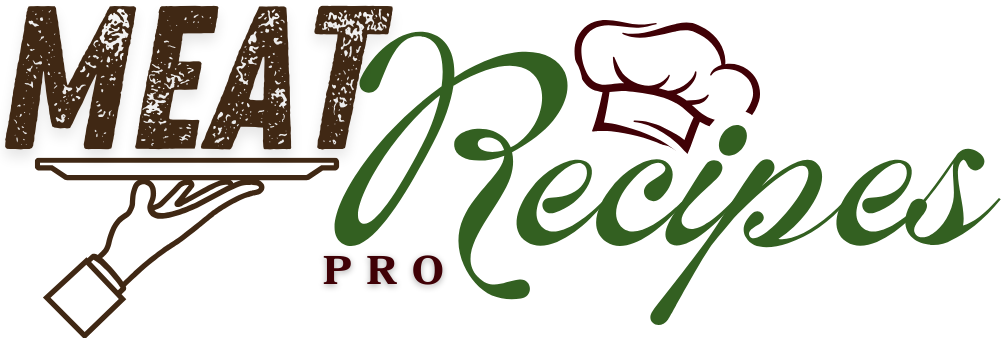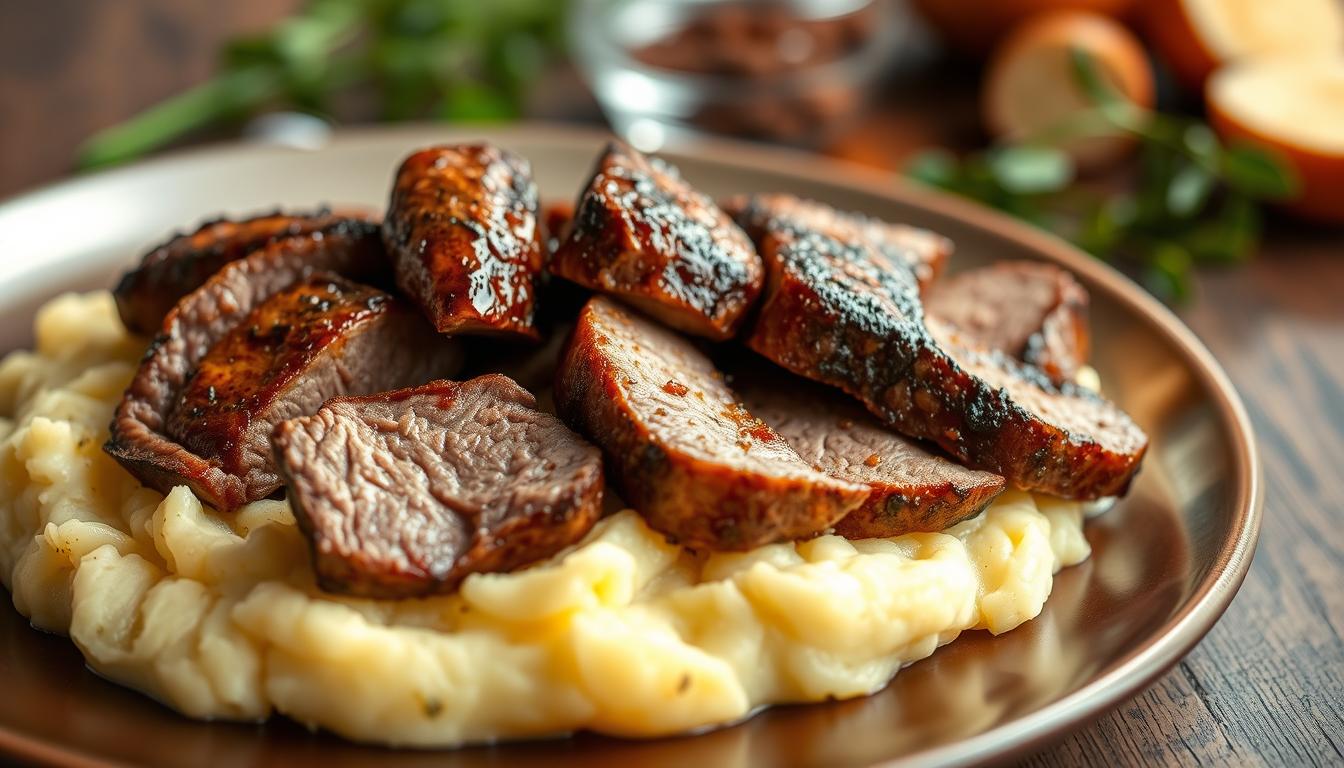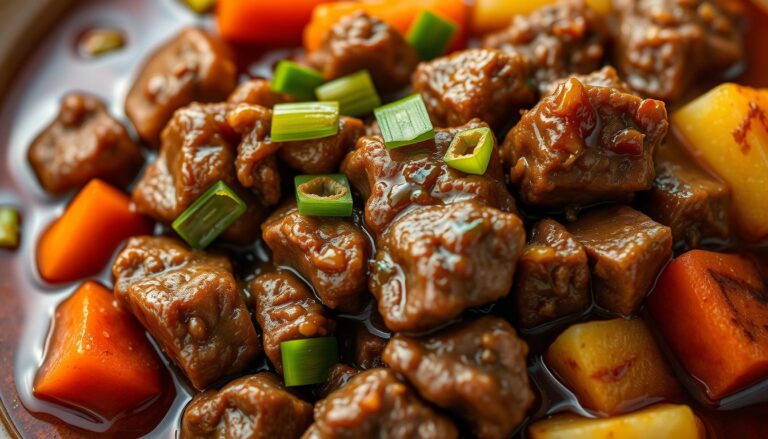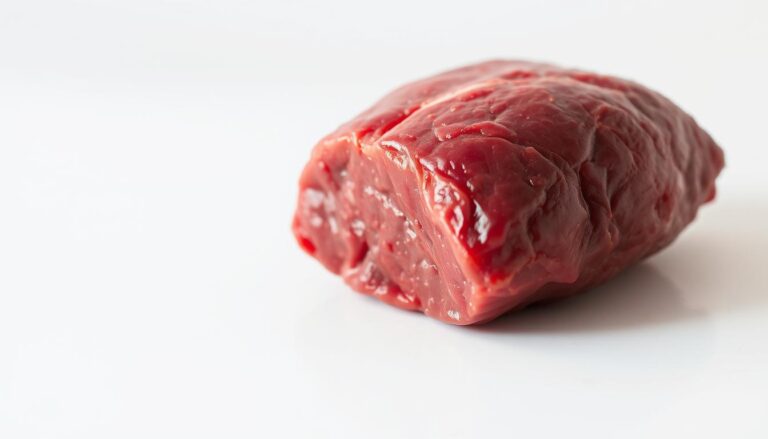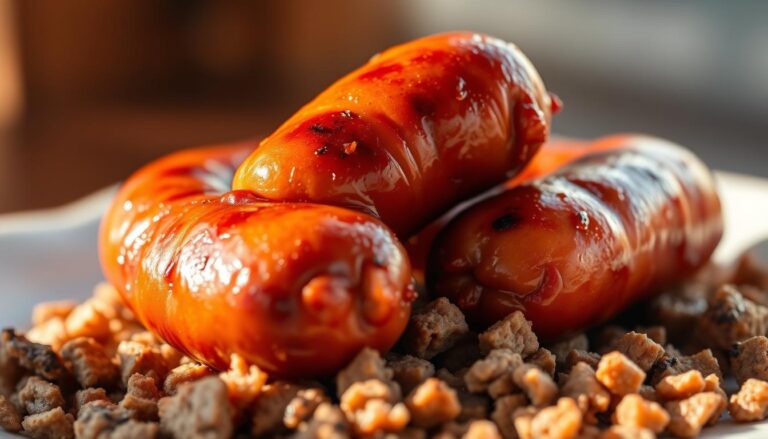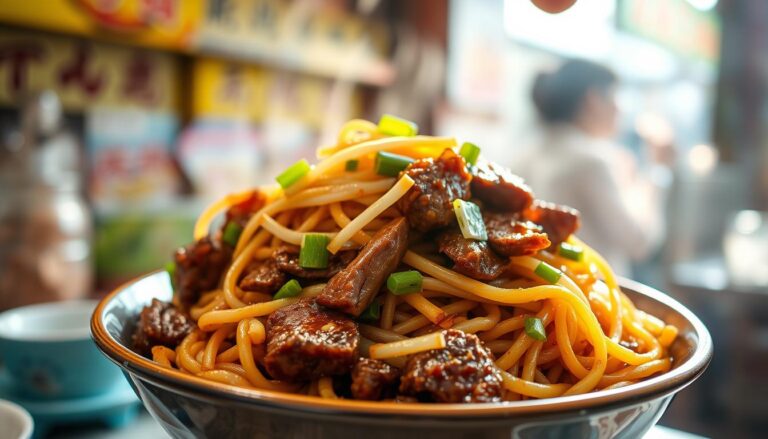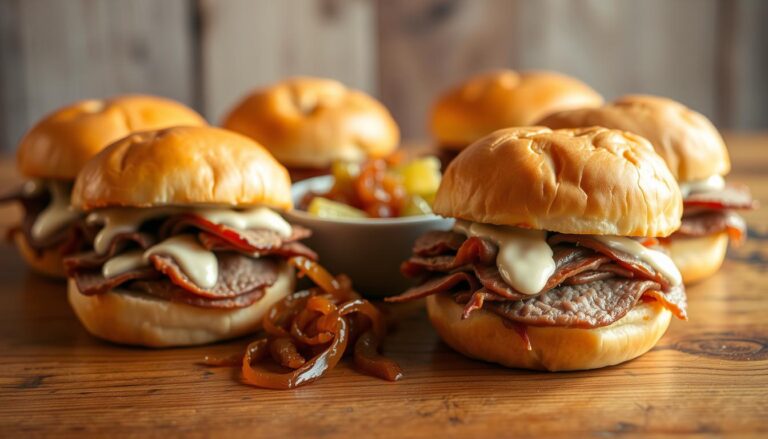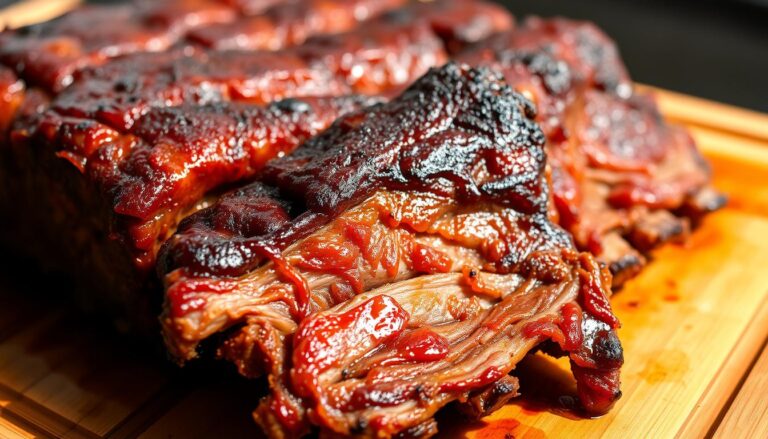Beef Tenderloin Tips Recipe: Delicious & Easy to Make
Beef tenderloin tips recipe is your answer when a busy evening calls for comfort without the fuss. Those end cuts and trimmings give you filet-like tenderness, and with just a little care, you can turn them into a quick, flavorful meal that feels both simple and special.
In under 30 minutes, you sear bite-sized pieces in a hot cast-iron pan, then build a rich mushroom gravy in the same skillet. Deglaze with beer, wine, or stock to capture deep, savory flavor.
Target about 130°F for medium-rare so your steak bites stay rosy and tender. Avoid crowding the pan by cooking in batches; that preserves the crust and the fond you need for the sauce.
You’ll also learn smart swaps, the best cookware, and how to store leftovers for up to four days. With a few simple steps, you can make weeknight dinner feel like a table-side win.
Table of Contents
Why You’ll Love This Beef Dinner Right Now
A fast-cooked cut with a mushroom gravy gives you big flavor without the wait. A hot pan and a quick sear lock in juices so the meat stays tender even when you’re pressed for time. This makes it an ideal dinner for busy weeknights.
Simple ingredients create deep, savory results: mushrooms, onion, garlic, beef broth, and a dash of Worcestershire build a pan gravy that comes together in minutes. Serve the meat over mashed potatoes so every drop of sauce gets used.
You’ll get steakhouse-level flavor without long simmering. The cuts cook fast, need little fat, and respond well to a quick rest before serving. Balance the richness with a crisp salad or steamed greens.
“Pan-seared pieces and a quick gravy turn pantry staples into a dinner you’ll want to repeat.”
- Streamlined ingredients for big flavor with minimal fuss.
- Consistent results if the pan is properly heated and you avoid over-stirring during the sear.
- Easy to scale for a family meal or a cozy two-person plate.
What Are Tenderloin Tips and How They Compare to Steak Tips
These small pieces pack big texture and a smart value. The narrow end of the whole beef tenderloin tapers into a tail that won’t make uniform steaks. Butchers trim that area into tenderloin tips and trimmings. Those pieces come from the same muscle as filet mignon, which is why they feel so buttery when you cook them right.
How they differ from generic steak tips: steak tips often come from sirloin or other muscles. They can be flavorful but not as naturally soft as tenderloin tips. Avoid packs labeled “stew meat” for quick sautés; those cuts need slow, moist cooking instead of a hot pan sear.
- Irregular shapes come from the tapered tail and assorted trimmings.
- Cut oversized pieces into uniform chunks so they sear evenly.
- Plan batch cooking when sizes vary—pull smaller pieces earlier to prevent overcook.
- Lean profile means a fast sear and a rich sauce (mushrooms and onion) make a perfect match for a simple weeknight dinner.
“You can expect steakhouse quality on a budget when you season simply and use solid technique.”
Ingredients You’ll Need for Big Flavor
A small set of smart ingredients delivers a rich, quick pan sauce. Gather these items before you start so cooking moves smoothly.
Beef, mushrooms, onion, garlic, butter, and pantry staples
Typical amounts: 1–1.25 lb beef tenderloin, 8–10 oz mushrooms, 1/2 cup sliced onion, 2 garlic cloves, and 1–2 tablespoons butter.
Use kosher salt and freshly ground black pepper to season at the start and again to taste at the end.
Worcestershire sauce, soy, and seasoning options
Add 2 teaspoons Worcestershire sauce for umami. A splash of soy will also deepen savory notes.
Keep dried thyme optional for a mild herbal lift.
Beer, wine, or beef broth for deglazing and gravy
Choose 1/2 cup beer, dry red wine, or 1–1.5 cups beef broth to deglaze and build the sauce.
Have 1 tablespoon olive oil for the initial sear and cornstarch or flour on hand to thicken the gravy if needed.
- You’ll cut the meat into bite-sized pieces so they sear fast and stay juicy.
- Minced garlic goes in after the vegetables soften to avoid burning.
- Unsalted butter adds gloss and control over seasoning.
Best Pan and Tools: Cast-Iron Skillet, Heavy Stainless, or Dutch Oven
Choose a heavy pan that holds heat so each piece browns quickly and evenly. The right cookware changes a simple sear into a deep crust and a rich base for sauce.
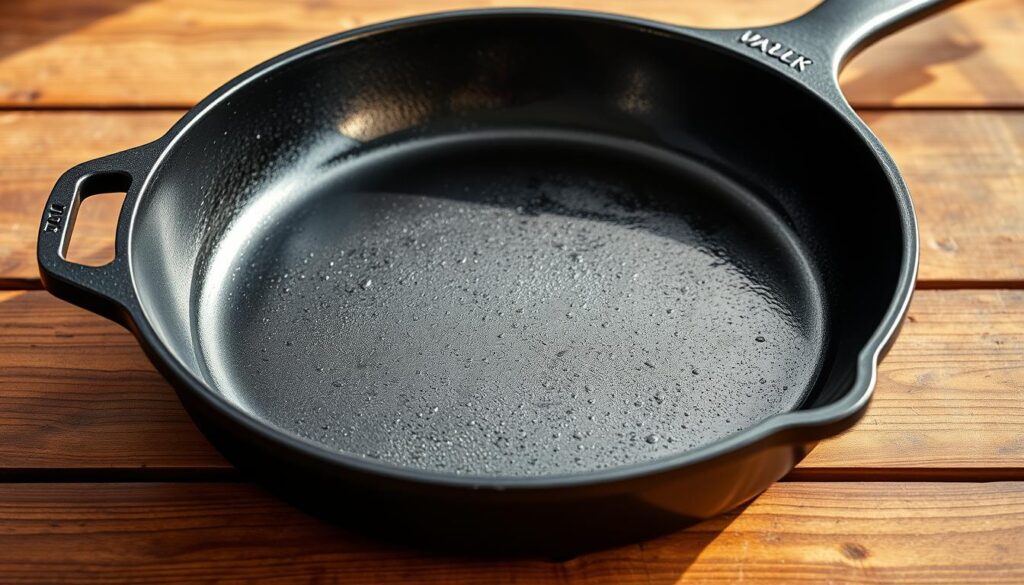
Which cookware works best: a 12-inch cast-iron skillet gives the deepest, most even sear for about 1–1.5 pounds of meat. Heavy stainless or a Dutch oven are good alternatives if you prefer less surface seasoning.
Why medium-high heat and avoiding crowding matters
Preheat the pan over medium-high heat until the oil just shimmers or begins to smoke. That cue means the surface will brown rather than steam.
- You’ll preheat a sturdy pan—cast-iron, heavy stainless, or a Dutch oven—so it retains heat when you add the beef.
- You’ll wait for the oil to shimmer or just start to smoke; this produces a true sear for each steak piece.
- You’ll avoid crowding by working in batches; this keeps temperature up and forms a crust that locks in juices.
- You’ll keep the fond in the pan after searing because those browned bits are the flavor base for your gravy.
- You’ll use tongs for quick flipping and a wooden spoon to scrape up fond when deglazing.
- You’ll let the pan come back to temperature between batches to ensure consistent searing.
Extra gear: consider a splatter guard to keep the stove tidy and a thermometer to check doneness precisely. After searing at medium-high heat, lower to medium to build the sauce without burning the fond.
“A heavy pan keeps temperature steady so your final plate stays juicy and well-browned.”
beef tenderloin tips recipe: Step-by-Step Instructions
Give the pieces time at room temperature — this small step makes a big difference in even doneness. Pat them dry and season generously with salt and black pepper. Let sit about 30 minutes so the center loses chill.
Prep and sear
Preheat a large pan over medium-high heat. Add 1 tablespoon oil. Sear the steak pieces 1 minute undisturbed, then rotate until browned on all sides — about 3 total minutes. Work in batches so the pan stays hot. Remove to a plate and set aside.
Build the sauce
Reduce to medium. Add 2 tablespoons butter, then the onion and mushrooms; cook 6–7 minutes until liquids cook off and onions start to caramelize. Add garlic for 30–45 seconds.
Finish and serve
Pour in 1–1.5 cups beef broth and 2 teaspoons worcestershire sauce, scraping the fond to lift flavor. Whisk 1 tablespoon cornstarch with 2 tablespoons cold water, stir in, and simmer ~2 minutes to thicken the sauce. Return the beef and any juices; warm 1–2 more minutes. Taste, then adjust salt and pepper. Serve over potatoes with extra gravy spooned on top.
Cook Times, Doneness, and Using a Thermometer
Use an instant-read thermometer to know exactly when each piece is done. Small chunks reach doneness fast, so tool-led checks beat guesswork. Aim for a tender medium-rare finish at about 130°F.
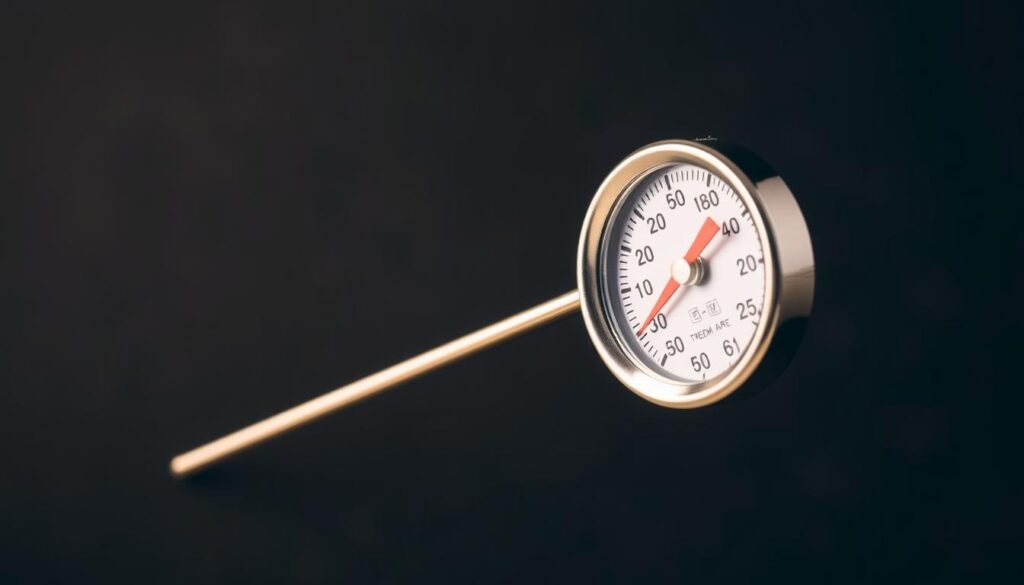
Target Temperature and Carryover
You’ll pull most pieces at roughly 130°F for a rosy center. Smaller bits finish sooner; remove them early so larger pieces can keep cooking.
Batch Cooking and Heat Control
Sear quickly over medium-high heat—this crust forms in a few minutes. Then finish the protein gently in the pan over medium so the exterior doesn’t toughen.
- You’ll use an instant-read thermometer and aim for about 130°F for medium-rare; carryover is small with bite-sized pieces.
- The initial sear takes just a few minutes; finishing in the sauce usually needs 1–2 more minutes.
- Remove smaller pieces first during batch cooking to avoid overcook and keep the pan hot between batches.
- Finish in a gentle simmer with a knob of butter and a clove of garlic if desired, then rest briefly so juices redistribute.
Smart Swaps and Variations
Swap components freely to fit what’s in your pantry and still end up with a hearty, sauce-forward plate.
Liquids: beer, wine, or stock
Beer adds malt and a faint bitterness that pairs well with mushrooms. Dry red wine brings acidity and depth. Beef stock keeps the flavor straightforward and rich.
Thickeners: slurry or roux
A cornstarch slurry thickens quickly with a glossy finish. A butter-and-flour roux gives a richer mouthfeel and a silkier gravy if you have a few extra minutes.
Alternate cuts and low-and-slow
If you want a cheaper option, use sirloin or other tender steak cuts for a similar result when seared. For a fall-apart texture, braise the pieces low and slow in stock until they are very tender.
- You’ll lean on mashed potatoes as the ultimate gravy sponge; buttery mash is classic.
- You’ll rotate in rice or egg noodles as a different side that catches every drop.
- Add sautéed green beans, roasted Brussels sprouts, or a tangy salad to brighten the plate.
- Toast crusty bread to mop up leftover gravy and finish with chopped parsley for color.
“A cast-iron sear pairs beautifully with starchy sides that catch pan sauces.”
Storage, Reheating, and Leftover Ideas
A quick plan for cooling and reheating keeps the sauce glossy and the meat tender. Cool leftovers promptly and transfer them to airtight containers. Refrigerate up to four days so you can enjoy the meal again during the week.
Reheating basics
Warm portions in a pan over heat medium with a splash of beef stock or water to loosen the gravy. Stir gently for a few minutes and avoid boiling; that keeps the meat tender and the sauce smooth.
Leftover transformations
Turn cooled meat into a quick stroganoff by adding a teaspoon of sour cream and serving over egg noodles. Or pile warmed cuts and extra gravy on toast for open-faced sandwiches with a simple green side.
| Storage | Time | Reheat tip |
|---|---|---|
| Airtight container | Up to 4 days | Pan, splash of stock, stir few minutes |
| Microwave-safe dish | 1–2 days best | Short bursts, stir between intervals |
| Freeze (last resort) | 2–3 months | Thaw slowly, reduce heat medium when reheating |
“Set aside some meat before thickening if you want a lighter next-day soup.”
Nutrition Snapshot and Lighter Tweaks
This dish delivers a solid protein punch while letting you dial fat and calories up or down with simple swaps.
Protein, fat, and saturated fat context
You can expect roughly 27 g of protein per serving from lean cuts. That makes this plate filling without being heavy.
Fat totals vary with how much butter and oil you use. Trim visible fat and you’ll lower saturated fat substantially.
How to reduce butter and choose leaner swaps
- You’ll replace half the butter with extra-virgin olive oil to cut saturated fat while keeping gloss in the sauce.
- Use unsalted butter and add kosher salt near the end to control seasoning as the sauce reduces.
- Load the plate with vegetables and salad to balance calories; mushrooms and onions add body with few extra calories.
- Minced garlic and fresh herbs boost flavor without extra fat or sodium.
- If you track macros, plug your exact ingredients into a nutrition calculator for an accurate snapshot.
| Nutrient | Typical per serving | How to lower |
|---|---|---|
| Protein | ~27 g | Use a modest portion of lean tenderloin |
| Total fat | Varies (depends on butter/oil) | Trim fat, swap oil for some butter |
| Saturated fat | Lower with swaps | Limit butter to sauce finish |
“Choose a lean cut and small portions of sauce to keep the plate satisfying and lighter.”
Pro Tips to Nail the Sear and Sauce Every Time
A hot pan and simple timing change everything. Preheat a 12-inch cast-iron skillet or a heavy Dutch oven until oil just shimmers. Pat the meat dry so it browns instead of steaming.
Work in batches and set aside each batch so the pan temperature stays high and the crust stays crisp. Do not wipe the pan after searing; the fond is your flavor base.
Hot pan, dry surface, and minimal stirring
- You’ll dry the meat thoroughly before searing so it browns.
- You’ll preheat the skillet over medium-high until the oil shimmers, then add beef and let it sit undisturbed.
- You’ll flip with tongs and rotate pieces so all sides brown evenly.
Use the fond and season at the end
Deglaze with broth, beer, or wine and scrape the fond into your sauce. Thicken with a cornstarch slurry or a brief roux off the heat, then return to a simmer until it lightly coats a spoon.
“Scrape the pan—the browned bits are concentrated flavor you don’t want to lose.”
| Step | Why it matters | Quick action |
|---|---|---|
| Preheat skillet | Ensures instant sear and crust | Heat until oil shimmers |
| Batch cook | Keeps pan hot, avoids steaming | Cook 3–4 pieces at once, set aside |
| Finish sauce | Builds depth and controls salt | Deglaze, thicken, season at end |
Final note: If the sauce tightens too much, whisk in a splash of stock. Finish with chopped herbs and a final grind of pepper to brighten the plate.
Conclusion
In short, this one-pan method turns trimmed pieces into a reliable, steakhouse-style dinner in minimal time. The pan sear and mushroom gravy pair beautifully with mashed potatoes, rice, or noodles.
You’ve got a repeatable approach: sear hot, build an easy sauce, and finish the cuts until juicy and tender. Store leftovers up to four days and reheat with a splash of stock so the gravy stays glossy.
Use beer, wine, or stock to deglaze and pick a slurry or roux for thickness. Print this recipe, save it for weeknights, and rely on these tips the next time tenderloin tips are on sale.
